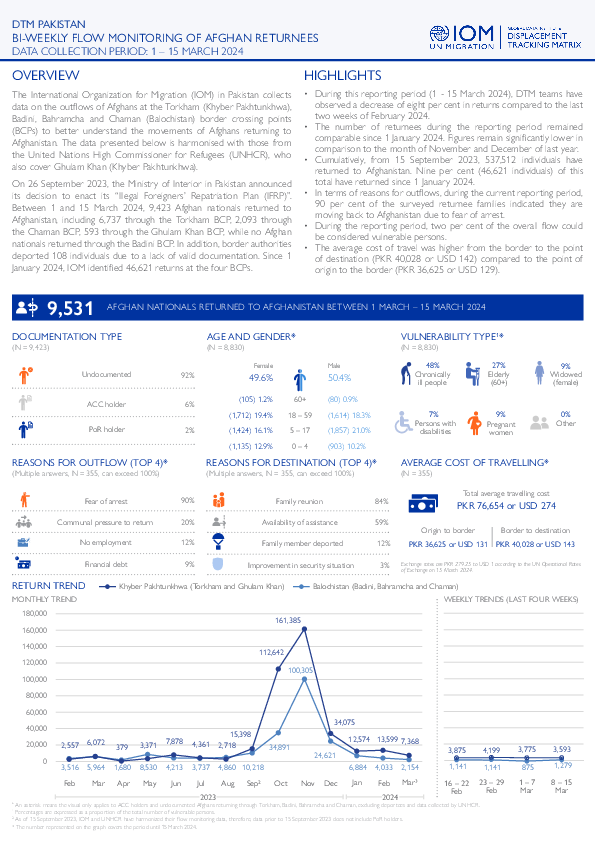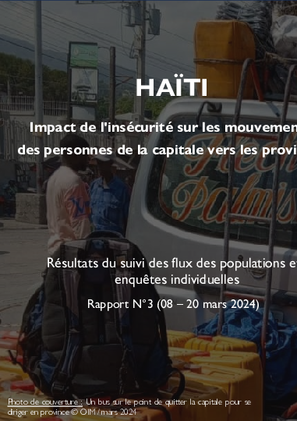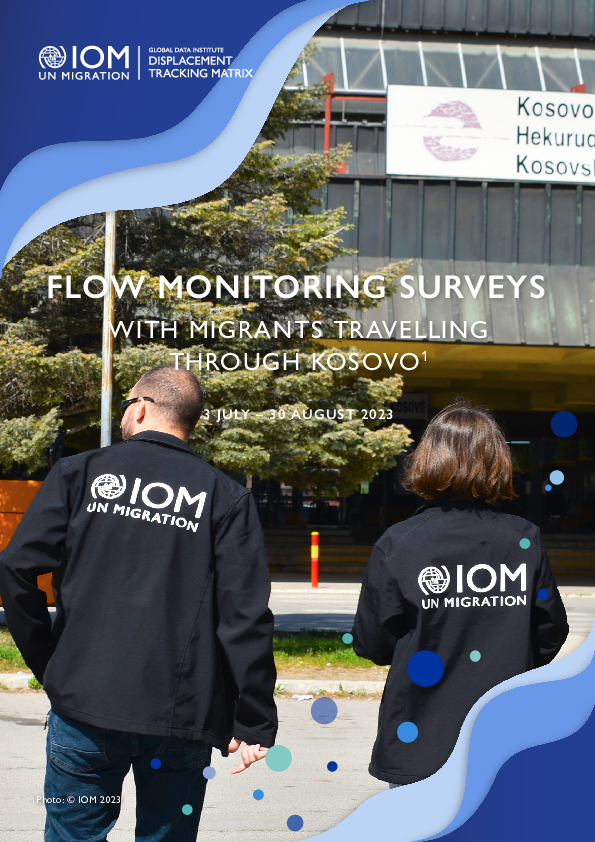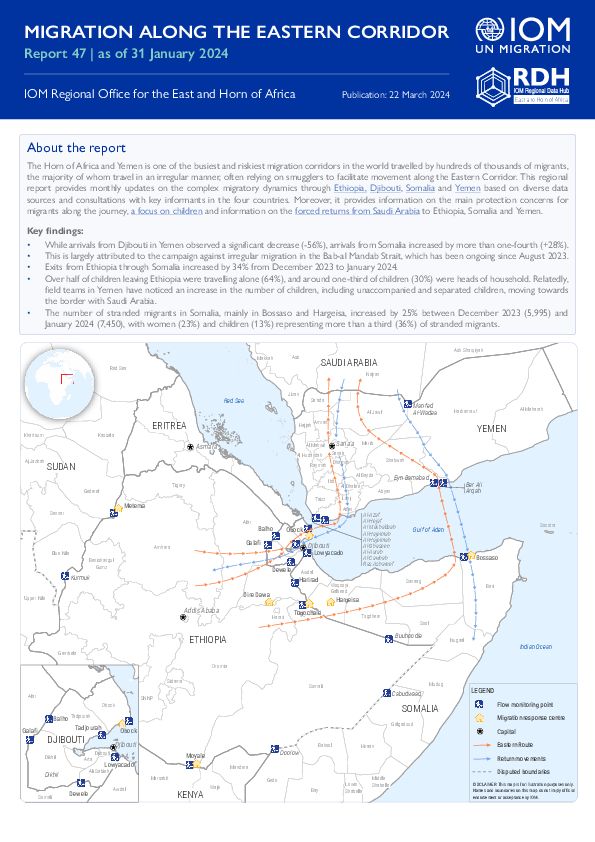-
Countries
-
Data and Analysis
-
Special Focus
-
Crisis Responses
Flow Monitoring

Contact
DTM Ethiopia, DTMEthiopia@iom.int
Language
English
Location
Ethiopia
Period Covered
Jan 01 2024
Jan 31 2024
Activity
- Flow Monitoring
In January 2024, a total of 40,464 movements were observed across the six flow monitoring points (FMPs) in Ethiopia. This represents a 5.7% increase in daily average movements in comparison with December 2023 when an average of 1,235 movements per day were observed.
Outgoing movements (63%) during January decreased while incoming movements (37%) increased compared to the previous month, mainly due to increased incoming flows of returning migrants to Ethiopia through different entry points. A total of 25,373 outgoing movements were observed, out of which 12,558 (49.5%) were heading to Saudi Arabia, 5,404 (21.3%) were going to Kenya, 2,182 (8.6%) to Djibouti, 1,682 (6.6%) to Somalia, 1,005 (4%) to South Africa, 954 (3.8%) to Yemen, and 552 (2.2%) to Sudan, while remaining movements were heading to other Southern African, Middle Eastern, and North American countries.
At the same time, 15,091 incoming movements were observed, out of which 10,401 (68.9%) originated from Sudan, while 2,291 (15.2%) came from Kenya, 1,392 (9.2%) from Djibouti, 882 (5.8%) from Somalia and 125 (0.9%) came from other Middle Eastern and Horn of Africa countries. Most incoming movements were by Ethiopians (65.3%), followed by Sudanese nationals (33.5%). Returning Ethiopians departed from Sudan (52.7%), Kenya (23.1%), Djibouti (14%), Somalia (8.9%), Yemen (1.2%), and South Sudan (0.1%).

Contact
DTM Europe, DTMMediterranean@iom.int
Language
English
Location
Republic of Moldova
Period Covered
Jan 01 2023
Dec 31 2023
Activity
- Survey
- Flow Monitoring
Key Findings
- 20 per cent of respondents have or live with people with specific needs or serious medical conditions
- Main health issues for women include chronic disease or serious medical conditions (12%), pregnancy or lactating (3%), difficulty walking (2%) and visual impairment (1%)
- Main health issues for men include chronic disease or serious medical conditions (22%), difficulty walking (5%), visual impairment (4%) and hearing impairment (2%)
- 61 per cent of those with a health condition intend to stay in the Republic of Moldova
- Top 3 needs include financial support (64%), medication (32%) and health services (31%)
- Majority of respondents report no barriers to healthcare services (84%)
- Those who do report barriers cite costs (9%), unavailable services (2%), language barrier (1%) and waiting times (1%)

Contact
DTMAfghanistan@iom.int
Language
English
Location
Afghanistan
Period Covered
Mar 10 2024
Mar 16 2024
Activity
- Survey
- Flow Monitoring Survey
- Flow Monitoring
In response to recent movements, IOM Afghanistan re-launched its DTM Flow Monitoring activity at the beginning of 2024 to better understand the mobility dynamics at Afghanistan’s borders. On 10 January 2024, DTM began deploying field teams at four border crossing points with the Islamic Republic of Iran (IRN) and Pakistan (PAK), expanding to another border crossing point, Ghulam Khan, as of 11 February (see map below for the locations of all five crossing points), to conduct two interlinked exercises. The first is a headcount of all individuals entering or leaving Afghanistan (including returnees), also called Flow Monitoring Counting (FMC), to gauge flow volume. The second is a survey of randomly selected Afghan national individuals or groups entering or leaving Afghanistan, also called the Flow Monitoring Survey (FMS), to understand the profiles, motivations, and vulnerabilities of the target population. This snapshot provides key findings combining various IOM data sources, including DTM Afghanistan’s FMC and FMS activities, DTM Pakistan’s Flow Monitoring of Afghan returnees, and IOM Afghanistan’s Cross-Border Post-Arrival Humanitarian Assistance (CB-PAHA) program, for the period 10 to 16 March 2024. For more information about methodology, see the section in the last page of this report titled “IOM INFLOW DATA.”
This report provides insights into the profiles, experiences, needs, routes travelled and intentions of migrants transiting through the Western Balkans.
IOM surveyed 1,698 migrants from 1 February to 29 February 2024 in Albania, Bosnia and Herzegovina, Montenegro, North Macedonia, Serbia and Kosovo*.
* References to Kosovo* shall be understood in the context of UN Security Council Resolution 1244 (1999).

Contact
DTM Pakistan, DTMPakistan@iom.int
Language
English
Location
Pakistan
Period Covered
Mar 01 2024
Mar 15 2024
Activity
- Flow Monitoring
On 26 September 2023, the Ministry of Interior in Pakistan announced its decision to enact its “Illegal Foreigners’ Repatriation Plan (IFRP)”. Between 1 and 15 March 2024, 9,423 Afghan nationals returned to Afghanistan, including 6,737 through the Torkham BCP, 2,093 through the Chaman BCP, 593 through the Ghulam Khan BCP, while no Afghan nationals returned through the Badini BCP. In addition, border authorities deported 108 individuals due to a lack of valid documentation. Since 1 January 2024, IOM identified 46,621 returns at the four BCPs.
Key finding in the Migration Along the Eastern Corridor in January 2024:
• While arrivals from Djibouti in Yemen observed a significant decrease (-56%), arrivals from Somalia increased by more than one-fourth (+28%).
• This is largely attributed to the campaign against irregular migration in the Bab-al Mandab Strait, which has been ongoing since August 2023.
• Exits from Ethiopia through Somalia increased by 34% from December 2023 to January 2024.
• Over half of the children leaving Ethiopia were travelling alone (64%), and around one-third of children (30%) were heads of household. Relatedly, field teams in Yemen have noticed an increase in the number of children, including unaccompanied and separated children, moving towards the border with Saudi Arabia.
• The number of stranded migrants in Somalia, mainly in Bossaso and Hargeisa, increased by 25% between December 2023 (5,995) and January 2024 (7,450), with women (23%) and children (13%) representing more than a third (36%) of stranded migrants.

Contact
DTM Haiti, dtmhaiti@iom.int
Language
English
Location
Haiti
Period Covered
Mar 08 2024
Mar 20 2024
Activity
- Survey
- Flow Monitoring Survey
- Flow Monitoring
In recent weeks, armed attacks have intensified in the Metropolitan Area of Port-Au-Prince (MAPAP), the capital of Haiti. In addition to creating displacement within the MAPAP, attacks and generalized insecurity are pushing more and more people to leave the capital to find refuge in provinces, taking the risks of passing through gangs-controlled routes. In order to monitor these movements towards provinces and inform appropriate response strategies, DTM has launched data collection at several of the most used bus stations in the capital (see page 5 for more details on the methodology). Since the start of this activity, on 8 March, until 20 March, this activity allowed to observe the movements of 33,333 people leaving the MAPAP (see pages 3 and 4 for more details on the profile of these people ). The majority of them (62%) took means of transport heading towards the Grand Sud departments (Grande’Anse, South, Nippes and South-East). It should be noted that this region already hosts more than 116,000 people who had in vast majority, fled the MAPAP in recent months (see the report on displacement in the Grand Sud).
It should be emphasized that provinces do not have sufficient infrastructures and host communities do not have sufficient resources that can enable them to cope with these massive displacement flows coming from the capital.

Contact
DTM Haiti, dtmhaiti@iom.int
Language
French
Location
Haiti
Period Covered
Mar 08 2024
Mar 20 2024
Activity
- Survey
- Flow Monitoring Survey
- Flow Monitoring
Depuis quelques semaines, les attaques armées se sont intensifiées dans la Zone Métropolitaine de Port-au-Prince (ZMPP), la capitale d’Haïti. En plus de créer des déplacements à l’intérieur de la ZMPP, les attaques et l’insécurité généralisée poussent de plus en plus de personnes à quitter la capitale pour trouver refuge dans les provinces, en prenant les risques de passer par des routes contrôlées par des gangs. Afin de suivre ces mouvements vers les provinces et informer les stratégies de réponse adéquates, la DTM a lancé des collectes de données au niveau de plusieurs stations de bus les plus utilisées dans la capitale (voir la page 5 pour plus de détails sur la méthodologie). Depuis le début de cette activité, le 08 mars, jusqu’au 20 mars, cette activité a permis d’observer les mouvements de 33 333 personnes quittant la ZMPP (voir les pages 3 et 4 pour plus de détails sur le profil de ces personnes). Ces personnes ont en majorité (62%) pris des moyens de transport se dirigeant vers les départements du Grand Sud (Grande’Anse, Sud, Nippes et Sud-Est). Il est à noter que cette région accueille déjà plus 116 000 personnes qui avaient en grande partie fui la ZMPP durant des mois passés (voir le rapport sur les déplacements dans le Grand Sud).
Il convient de souligner que les provinces n’ont pas suffisamment d’infrastructures et les communautés hôtes n’ont pas de ressources suffisantes qui peuvent leur permettre de faire face à ces flux de déplacements massifs venant de la capitale.

Contact
IOMASTANA@iom.int
Language
English
Location
Kazakhstan
Period Covered
Jul 01 2023
Sep 30 2023
Activity
- Survey
- Flow Monitoring Survey
- Flow Monitoring
- Mobility Tracking
The quarterly migration situation report is developed by combining secondary data obtained from different sources, including government agencies, international organizations, non-profit entities, and other types of organizations. More specifically, the report on the third quarter of 2023 was derived from data of the Ministry of Internal Affairs, Bureau of National Statistics, and Border Service of Kazakhstan. The data was compiled through a combination of published sources and direct requests to the partners and government agencies.

Contact
DTM Europe, DTMMediterranean@iom.int
Language
English
Location
Kosovo 1244
Period Covered
Jul 03 2023
Aug 30 2023
Activity
- Survey
- Flow Monitoring
This report presents the results of the second round of the Displacement Tracking Matrix (DTM) Flow Monitoring Surveys (FMS) collected in Kosovo* from 3 July to 30 August 2023. IOM interviewed a total of 51 individual respondents. The first round of FMS was carried out in June and July 2022. FMS provides a snapshot of the profiles, experiences and needs of migrants residing in Kosovo*. The survey asks questions on demographics, education and employment backgrounds, the circumstances of the migration journey and migration factors, as well as future intentions.
* References to Kosovo shall be understood in the context of United Nations Resolution 1244 (1999).
Pagination
- Previous page
- Page 21
- Next page

